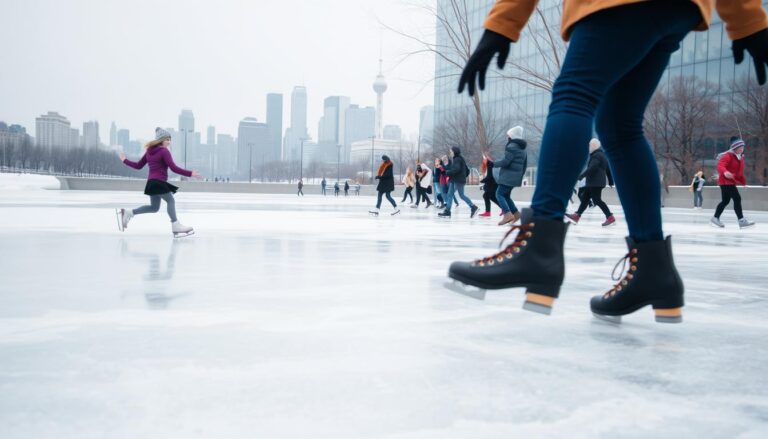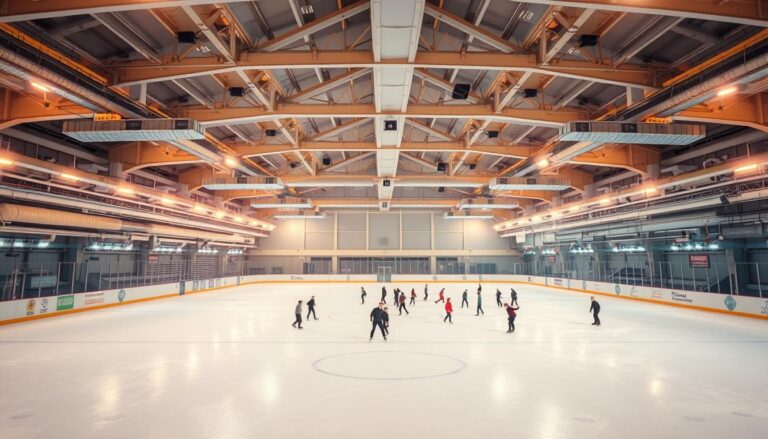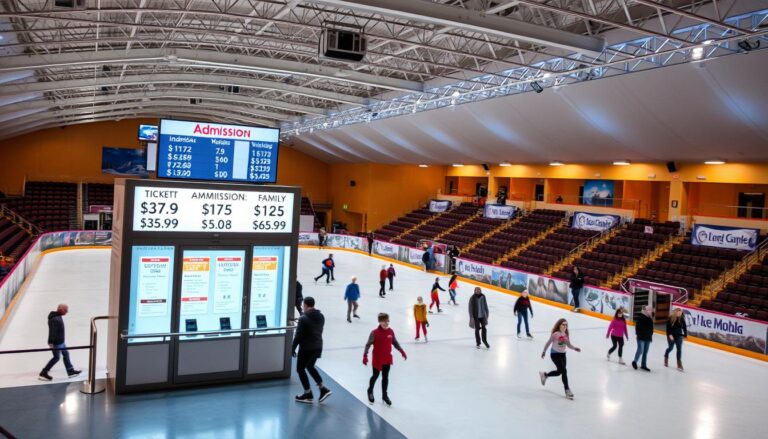Skating 101: Understanding the Fundamentals
Imagine a world where motion meets freedom – welcome to the exhilarating realm of skating. This extreme sports adventure turns ordinary movement into an art form. It combines balance, speed, and excitement.
Whether you dream of gliding on ice, rolling through cities, or mastering figure skating, your journey begins here. Skating is more than a hobby; it’s a skill that blends physical strength, technical skill, and personal expression.
Skating is a full-body workout that builds muscles, improves coordination, and unleashes your inner athlete. Professional skaters know that each type of skating requires unique skills. From figure skating’s grace to skateboarding’s street smarts, there’s something for everyone.
Beginners might feel scared, but every pro started where you are. The key is to learn the basics, get the right gear, and be open to learning. Skating is a lifestyle that connects you with a supportive community of fans.
Different skating styles offer unique experiences. Ice skating is smooth and great for beginners. Roller skating adds a retro vibe and urban flair. Inline skating tests your speed and agility. Skateboarding turns cities into playgrounds.
Safety is key in all skating. Wear the right gear, learn basic moves, and build your skills slowly. Every fall is a chance to learn and get better.
This guide will take you through skating’s history, teach you essential techniques, and help you pick the right style. Get ready to dive into a world where movement meets creativity.
What Is Skating: A Comprehensive Introduction
Skating is a world of movement that spans both winter and summer sports. It has evolved from a simple way to get around to a thrilling global activity. Whether you’re gliding on ice, rolling on wheels, or cruising on a skateboard, there’s something for everyone.
Skating is more than just moving on a surface. It’s an art, a sport, and a fun activity that brings people together from different cultures and places.
Origins and Evolution of Skating
Skating has a long history. Archaeologists found evidence of early humans using bone skates to move on frozen ground. This laid the groundwork for the skating we know today.
- Prehistoric bone skates discovered in Netherlands
- First documented ice skating in 13th-century Netherlands
- Technological advancements in skate design throughout centuries
Different Types of Skating Disciplines
Skating has grown into many exciting areas, each with its own style and skills.
- Ice Skating: A winter sport that includes figure and speed skating
- Roller Skating: A summer activity enjoyed indoors and outdoors
- Skateboarding: An urban sport that combines balance and creativity
- Inline Skating: A versatile discipline for fitness and fun
Basic Skating Terminology
Learning skating terms helps you feel more at ease in different areas.
| Term | Definition |
|---|---|
| Crossover | A technique for changing direction or keeping speed |
| Ollie | A basic skateboarding jump |
| Toe Stop | A braking feature on roller skates |
Whether you’re into winter or summer sports, skating offers a wide range of experiences. It’s perfect for people of all ages and skill levels.
Essential Safety Gear and Equipment for Beginners
Starting skating lessons is exciting, but safety comes first. The right gear makes your experience safe and fun. Whether you’re on ice or wheels, protecting yourself is key to learning.
Every beginner needs a safety kit. Your kit should include:
- Helmet (critical for head protection)
- Wrist guards
- Knee pads
- Elbow pads
- Proper skating footwear
Choosing the right gear is important. Badly fitting gear can hurt your safety and learning. Skaters say good gear is comfy and keeps you safe.
Ice skaters need extra care. Here’s what to add:
- Find skates that fit well but aren’t tight
- Make sure the blades are sharp
- Wear socks that keep you dry
- Think about wearing padded shorts for extra safety
Your safety gear is an investment in your skating. Instructors say it boosts confidence. It lets you learn without worrying about getting hurt.
Pro tip: Change your safety gear often, like helmets, after big hits or wear.
Choosing the Right Type of Skating for You
Exploring your perfect skating style is a fun journey. It’s about finding what you love and what you’re good at. Whether you prefer the elegance of figure skating or the cool vibe of roller skating, the right choice can make all the difference.
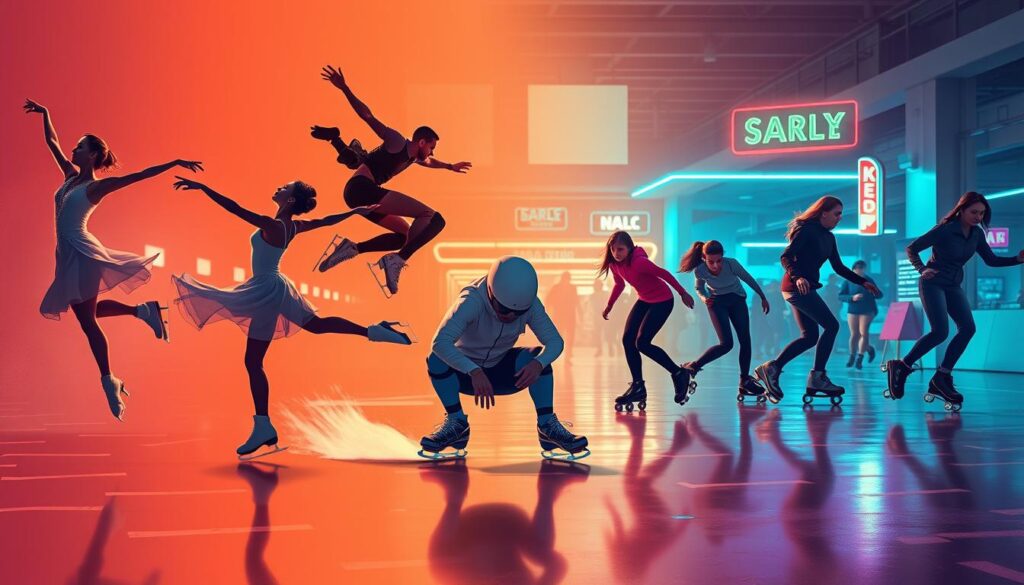
Skating is more than just a hobby; it’s a way to express yourself and stay fit. Your ideal skating path depends on many things, not just what you like.
Factors to Consider When Starting
- Personal interest and motivation
- Available local facilities
- Budget for equipment
- Time commitment
- Physical comfort and natural abilities
Age-Appropriate Skating Styles
Each skating style is best for different ages and skill levels. Roller skating is great for kids and adults starting out. On the other hand, figure skating needs more skill and practice.
Physical Requirements and Fitness Levels
Your fitness level is key when choosing a skating style. Some styles need more endurance, while others focus on skill and art.
| Skating Style | Fitness Level | Skill Complexity |
|---|---|---|
| Roller Skating | Beginner to Advanced | Low to Moderate |
| Figure Skating | Intermediate to Advanced | High |
| Inline Skating | Moderate to Advanced | Moderate |
Start your skating journey by knowing yourself. Pick a style that makes you happy, fits your fitness level, and keeps you eager to get better.
Ice Skating Basics: Getting Started on the Ice
Ice skating is a thrilling winter sport that combines grace, skill, and joy. It’s perfect for those who dream of gliding elegantly or want to improve their skills. Learning the basics is the first step to success.
Before hitting the ice, preparation is essential. Here are key tips for beginners:
- Wear properly fitted skates that support your ankles
- Dress in layers for comfortable movement
- Use protective gear like helmets and wrist guards
When you arrive at the ice rink, take time to get used to your surroundings. Your stance is everything in ice skating. Stand with your feet shoulder-width apart, knees slightly bent, and weight centered. This stance helps you stay stable and prevents falls.
Moving forward takes practice and confidence. Start by pushing off gently with one foot while keeping your body balanced. Keep your eyes forward – not down at your feet – to maintain proper alignment and prevent falls.
- Start with small, controlled movements
- Practice weight shifting between feet
- Use the rink’s wall for initial support if needed
Stopping is key in ice skating. The basic snowplow stop involves turning your toes inward and pushing your heels out, creating friction that slows you down. Many skating lessons focus on perfecting this fundamental technique.
Remember, everyone falls when learning ice skating. The key is to fall safely by bending your knees and protecting your wrists. With patience and practice, you’ll soon be gliding confidently across the ice!
Roller Skating Fundamentals: Mastering the Wheels
Summer sports fans are finding roller skating thrilling. It’s a mix of fitness, fun, and joy. Whether you want to skate on city streets or a rink, there’s something for everyone.
To start roller skating, you need to know the basics. You also need to pick the right place to skate. Here are the key things to help you skate with confidence.
Indoor vs Outdoor Roller Skating
Roller skating offers two main experiences:
- Indoor Skating: A controlled space with smooth floors
- Outdoor Skating: A challenge with different surfaces
| Indoor Skating | Outdoor Skating |
|---|---|
| Smooth wooden floors | Varied terrain (sidewalks, paths) |
| Consistent surface | Potential obstacles |
| Predictable movement | Requires more advanced skills |
Basic Roller Skating Techniques
Learning roller skating means getting good at a few key skills. These skills help you feel more confident and in control:
- Proper stance and balance
- Forward gliding
- Stopping techniques
- Turning and maneuvering
Common Beginner Mistakes
New skaters often face challenges. But with practice and knowing what to avoid, you can get better. Common mistakes include stiff posture, looking down, and tensing up.
Knowing these basics will help you skate better. Remember, the more you practice, the better you’ll get. And the fun of learning is just as good as the skating itself!
Figure Skating: Art Meets Athletics

Figure skating is a captivating winter sport that combines grace and power. It blends athletic precision with artistic expression. This creates a mesmerizing performance that draws in audiences from all over.
Figure skating is more than just moving on ice. Athletes turn the ice into a canvas of dynamic motion. They perform complex jumps, spins, and choreographed sequences. This requires incredible skill and years of training.
- Combines athleticism with artistic performance
- Requires exceptional balance and technical skill
- Performed in multiple competitive disciplines
The sport has several competitive categories that highlight different skills:
- Singles skating: Individual athletes perform solo routines
- Pair skating: Two athletes perform synchronized movements
- Ice dance: Focuses on rhythm and partnership
- Synchronized skating: Teams perform coordinated routines
Professional figure skaters spend hours perfecting techniques. They master the triple axel and elegant footwork. These athletes show incredible physical and artistic abilities.
Training for figure skating requires a lot of dedication. Skaters work on core strength, flexibility, and control. They also learn to express emotion through precise movement. The result is a breathtaking performance that turns ice into a stage of athletic poetry.
Inline Skating: Urban Sport Essentials
Inline skating turns city streets into your own playground. It mixes excitement with urban exploration. This sport gives you a thrilling way to move around the city while working out your whole body.
Inline skating is more than a sport; it’s a way of life. It combines fitness, travel, and a rush of adrenaline. Whether you’re new or want to improve, knowing the basics can help you conquer the city.
Choosing Your Perfect Inline Skates
Finding the right inline skates is important. You need to think about a few things:
- Skill level (beginner, intermediate, advanced)
- Intended skating environment
- Comfort and fit
- Wheel size and hardness
Street vs Park Skating Dynamics
Each place you skate has its own rules and gear. Knowing these can make your skating better and more fun.
| Skating Environment | Characteristics | Recommended Skates |
|---|---|---|
| Street Skating | Urban terrain, uneven surfaces | Larger wheels, sturdy frame |
| Park Skating | Smooth surfaces, trick-focused | Smaller, more maneuverable wheels |
For those who love inline skating: Always wear safety gear and learn proper techniques before trying hard tricks in the city. Your safety gear is as vital as your skates when you’re out exploring.
Skateboarding: From Basic Balance to Advanced Tricks
Skateboarding is more than just a sport—it’s a way to express yourself. It tests your limits and sparks your creativity. If you’re new to skateboarding, learning the basics is key to getting better.
Starting out means getting good at balance and feeling confident on your board. Beginners should work on these important skills:
- Proper stance and foot placement
- Weight distribution techniques
- Initial pushing and rolling mechanics
- Basic directional control
Skateboarding takes time and effort. Every small success leads to bigger tricks. Riders start with simple moves and then move on to harder ones.
Important things for skateboarding include:
- Understanding board anatomy
- Selecting the right skateboard equipment
- Learning safety rules
- Building muscle memory
Extreme sports fans see skateboarding as a tough but rewarding challenge. It combines physical skill with creativity. Whether you’re cruising or practicing tricks, you’re always pushing yourself.
Experts say to start with safety gear and practice on flat, smooth spots. Slowly getting better helps avoid injuries and boosts your confidence.
Proper Stance and Balance Techniques
Learning to skate starts with knowing how to balance your body. Skating lessons show that a good stance is key for all skating types. This includes ice skating, roller skating, and skateboarding.
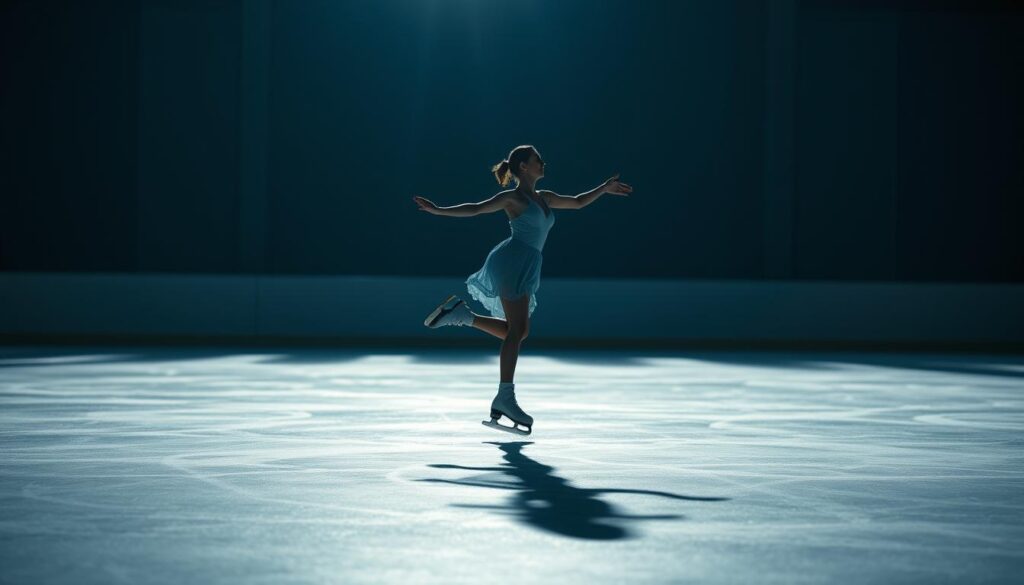
Without the right body alignment, skating is hard. Your stance affects your control, balance, and how well you skate. Let’s look at the main parts of a strong skating stance.
Weight Distribution Fundamentals
Getting your weight right is key in skating. You should keep your weight centered and balanced. This makes it easier to move. Here are some tips for better weight distribution:
- Keep your feet shoulder-width apart
- Bend your knees slightly to lower your center of gravity
- Distribute weight evenly between both feet
- Maintain a slight forward lean
Core Engagement Strategies
Your core muscles are important for balance in skating. To engage your core, try these:
- Activate your abdominal muscles
- Keep your back straight but not stiff
- Do balance exercises off the skating surface
- Focus on smooth, controlled movements
Pro Tip: Imagine a straight line from your ear through your shoulder, hip, and ankle. This line is your power position for maximum stability during skating lessons.
Breaking and Stopping Methods Across Skating Types
Learning to stop is essential for every skater. Whether you’re on ice, roller skates, or inline skates, you need to know how to control your speed. This helps prevent falls.
Ice skating has three main stopping methods to keep you safe:
- Snowplow Stop: This is easy for beginners. You point your toes inward and push your heels apart.
- T-Stop: Drag one skate behind your leading foot to slow down.
- Hockey Stop: This is for advanced skaters. You turn sideways and dig your blades into the ice.
Roller skating has its own stopping techniques:
- Toe Stop Drag: Use the rubber stopper at the front of quad skates to slow down.
- Plow Stop: Similar to the snowplow in ice skating, spreading legs to create resistance.
- T-Stop: Identical technique used in ice skating and inline skating.
Inline skating has unique stopping methods that test your control and coordination:
- Heel Brake Stop: Use the built-in brake on the back of one skate.
- Power Slide: An advanced method where you turn sideways and slide to a stop.
- T-Stop: A consistent technique across all skating styles.
Practice is key to mastering stopping skills in any skating style. Confidence comes from knowing and using these basic techniques well.
Common Injuries and Prevention Strategies
Skating lessons and extreme sports have risks. Knowing these risks is key to staying safe. Whether on ice or in the city, being aware of injuries helps you skate with confidence.
Skating is full of fast movements that test your body. Both pros and hobbyists need to focus on avoiding injuries. This means using the right gear and practicing smartly.
Most Common Skating Injuries
- Wrist sprains from falls
- Ankle strains
- Knee ligament injuries
- Bruises and abrasions
- Muscle pulls
Protective Gear Guidelines
| Skating Type | Essential Protective Gear | Recommended Additional Protection |
|---|---|---|
| Inline Skating | Helmet, Wrist Guards | Knee Pads, Elbow Pads |
| Ice Skating | Helmet, Padded Shorts | Ankle Support, Compression Gear |
| Skateboarding | Full-Face Helmet, Wrist Guards | Knee Pads, Elbow Pads, Shin Guards |
Warm-up Routines for Injury Prevention
Dynamic stretching is vital for skating. It makes your muscles and joints ready for action. Do exercises that feel like skating:
- Leg lunges
- Ankle rotations
- Gentle hip swings
- Arm and shoulder mobility exercises
Good skating lessons can help you avoid injuries. Stay safe, wear the right gear, and enjoy extreme sports!
Skating for Fitness and Health Benefits
Skating turns your workout into an exciting journey. Whether you’re on ice, roller skates, or inline skates, it’s a full-body workout. It keeps you moving and motivated.
Roller, ice, and inline skating are great for your heart. Each style works your body in different ways, burning calories and boosting fitness. An hour of skating can burn up to 600 calories, making it a fun exercise option.
- Improves cardiovascular endurance
- Strengthens leg muscles and core
- Enhances balance and coordination
- Low-impact exercise with high-intensity results
Different skating styles work different muscles. Inline skating targets your legs and hamstrings. Ice skating focuses on your core and balance. Roller skating works your whole body, keeping your muscles active and your metabolism high.
| Skating Style | Calories Burned (per hour) | Primary Muscle Groups |
|---|---|---|
| Roller Skating | 500-600 | Legs, Core, Glutes |
| Ice Skating | 450-550 | Core, Legs, Balance Muscles |
| Inline Skating | 600-700 | Quadriceps, Hamstrings, Calves |
Skating also boosts your mental health. It releases happy hormones, lowers stress, and makes staying active fun. The rhythmic motion and focus needed create a calming experience, unlike regular workouts.
Maintaining Your Skating Equipment
Keeping your skating gear in top shape is key for both fun and lasting use. Whether you love ice skating, roller skating, or skateboarding, taking care of your equipment is vital. It makes your skating better and lasts longer.
Skate maintenance is more than just cleaning. It’s about looking after your gear and keeping you safe and smooth on the ice or on wheels.
Essential Cleaning Techniques
Different skating styles need different cleaning methods:
- Ice skates need careful blade and boot maintenance
- Roller skates require regular wheel and bearing care
- Skateboards demand deck and truck cleaning
Cleaning Supplies You’ll Need
Get the right cleaning tools for your gear:
- Blade cloths for ice skates
- Bearing lubricant for roller skates
- Grip tape cleaner for skateboards
When to Replace Equipment Parts
Knowing when to replace parts is important for safety. Look out for these signs:
- Rust or deep scratches on ice skating blades
- Worn wheel bearings in roller skating
- Cracked decks in skateboarding
Regular checks and care will keep your gear in top shape. This way, you can enjoy skating for hours, whether on ice, wheels, or board.
Weather Considerations and Seasonal Skating
Skating changes with the seasons, bringing unique experiences. Each weather condition offers both challenges and opportunities for skaters.
Winter sports fans find magic on frozen surfaces. Ice skating is breathtaking when it’s cold. They can skate on outdoor rinks, frozen ponds, or indoor facilities.
- Winter skating safety requires proper gear
- Check ice thickness before outdoor skating
- Wear layered, moisture-wicking clothing
- Use appropriate winter skating footwear
Summer sports offer different skating adventures. Roller skating and inline skating are great in warm weather. Skaters can explore urban landscapes and outdoor trails.
| Skating Type | Winter Considerations | Summer Considerations |
|---|---|---|
| Ice Skating | Prime season | Indoor rinks available |
| Roller Skating | Indoor alternatives | Outdoor parks and trails |
| Inline Skating | Limited outdoor options | Urban and trail exploration |
Pro tip: Always adapt your skating technique and equipment to match seasonal conditions for maximum safety and enjoyment.
Skaters can enjoy activities all year by understanding seasonal changes. Whether skating on ice in winter or cruising in summer, being prepared is key.
Building a Skating Community: Groups and Events
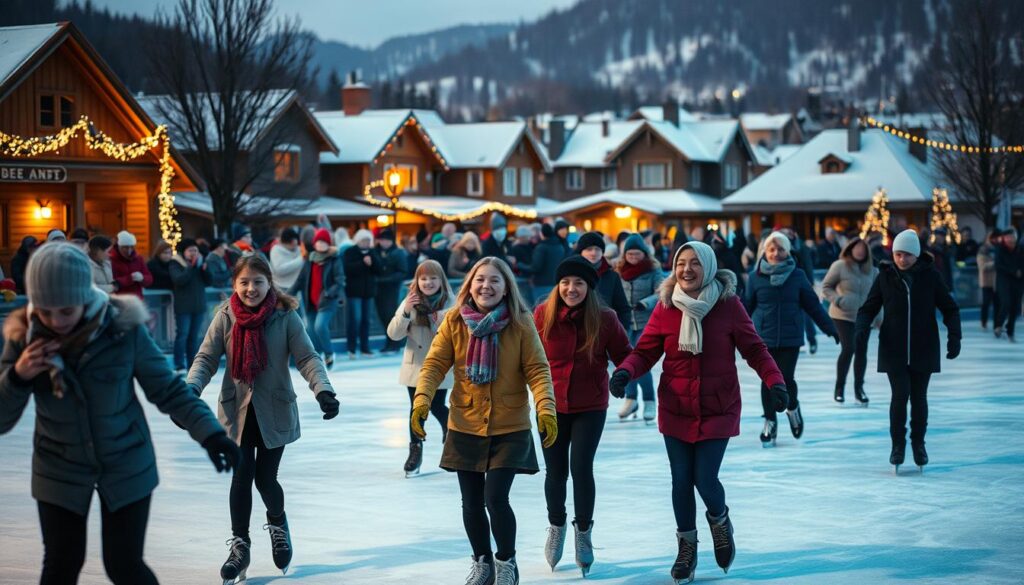
Skating becomes more fun when you meet others who love it. Joining skating groups lets you learn, get motivated, and make friends. It’s a great way to dive into the world of extreme sports.
Finding your skating friends can really boost your skills and love for it. Local skating lessons and events are perfect for meeting others. They offer a chance to learn and grow together.
- Local Skating Clubs: Connect with experienced skaters
- Online Communities: Share tips and experiences
- Regional Skating Events: Participate in competitions and meetups
- Skill-Sharing Workshops: Learn from professionals
Skating has many different groups. Roller skaters might join urban groups, while ice skaters find communities at rinks. Skateboarders meet at parks and urban spots to share tricks.
Technology has changed how we connect in skating. Social media and apps help find groups, plan meetups, and share progress. Whether you skate for fun or extreme sports, there’s a community for you.
Pro tip: Look for local groups at recreation centers, skate shops, and online forums. Your next skating adventure could be just a connection away!
Conclusion
Exploring the world of skating is exciting and full of discovery. It’s more than just moving around; it’s a skill that mixes balance, technique, and passion. Whether you’re into roller skating, ice skating, or skateboarding, your first lessons are just the start of a great journey.
Each type of skating has its own challenges and rewards. Start with the basics, practice often, and always be ready to learn. Skaters say that mastering this skill takes patience, hard work, and the courage to keep going, even when it’s tough.
Your skating journey is unique and keeps growing. As you get better, you’ll not only improve physically but also mentally and emotionally. You’ll gain confidence and connect with a supportive community of skaters. Remember, every pro was once a beginner, and your journey is about enjoying the ride, staying safe, and getting better with each try.
Take on the challenge, invest in good lessons, and most importantly, have fun. Your skating adventure is ready for you, one step at a time.

